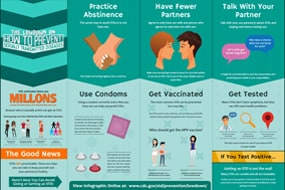The Lowdown Infographic Text Only Version

Download the ‘The Lowdown on How to Prevent STDs” Infographic – 30″ x 20″ poster.
The Lowdown on How to Prevent STDs
CDC estimates there are millions of new STD infections in the United States each year.
Anyone who is sexually active can get an STD. Some groups are more affected by STDs:
- Adolescents and Young Adults
- Gay, Bisexual, & other Men who have Sex with Men
- Pregnant Women and Infants
- Racial and Ethnic Minorities
The Good News: STDs ARE preventable. There are steps you can take to keep yourself and your partner(s) healthy. Here’s How You Can Avoid Giving or Getting an STD:
Practice Abstinence
The surest way to avoid STDs is to not have sex. This means not having vaginal, oral, or anal sex.
Use Condoms
Using a condom correctly every time you have sex can help you avoid STDs. Condoms lessen the risk of infection for all STDs. You still can get certain STDs, like herpes[1] or HPV[2], from contact with your partner’s skin even when using a condom.
Most people say they used a condom the first time they ever had sex,[3] but when asked about the last 4 weeks, less than a quarter said they used a condom every time.[4]
Step by step male condom instructions
Have Fewer Partners
Agree to only have sex with one person who agrees to only have sex with you. Make sure you both get tested to know for sure that neither of you has an STD. This is one of the most reliable ways to avoid STDs.
Get Vaccinated
The most common STD can be prevented by a vaccine. The HPV vaccine is safe, effective, and can help you avoid HPV-related health problems like genital warts and some cancers.
Who should get the HPV vaccine?
- All boys and girls ages 11 to 12, but the vaccine can start at age 9.[5]
- Everyone through age 26 years, if not vaccinated already.
Talk With Your Partner
Talk with your sex partner(s) about STDs and staying safe before having sex. It might be uncomfortable to start the conversationexternal icon, but protecting your health is your responsibility.
Get Tested
Many STDs don’t have symptoms, but they can still cause health problems.
- Talk with your health care providerexternal icon
- Search for CDC recommended tests
- Find a location to get tested for STDs
The only way to know for sure if you have an STD is to get tested.
If You Test Positive…
Getting an STD is not the end! Many STDs are curable and all are treatable. If either you or your partner is infected with an STD that can be cured, both of you need to start treatment immediately to avoid getting re-infected.